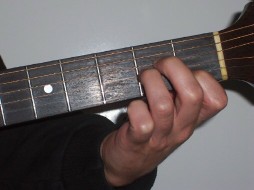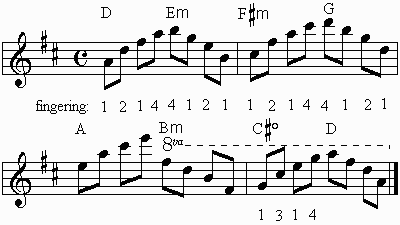 | |
|
Lesson 16
|
|||||||||||||||||||||||||
|
In this lesson we will look at time signatures, the moveable B minor chord and we will do some serious connecting of the pentatonic scales. D major scales in 7th Odd time signatures and the riff from Pink Floyd's Money |
|||||||||||||||||||||||||
|
|
|||||||||||||||||||||||||
|
Scales - D major/B Minor in 7th position This scale form should look familiar to you. We first learned it as 5th position C in lesson 8 |
|||||||||||||||||||||||||
|
This is the D major scale from Lesson 6 with all of the notes in 7th position.
|
D Major/B Minor Scale
7th Position 
|
D/Bm Pentatonic Scale
7th Position 
|
|||||||||||||||||||||||
|
Review of D major in 2nd and adding extensions
|
|||||||||||||||||||||||||
|
D in 2nd
|
D Pentatonic in 2nd
|
D/Bm in 2nd Ext
|
D/Bm Pentatonic in 2nd
|
||||||||||||||||||||||
|
D major and B minor in 9th position This is the same form as your 7th position C major scale from lesson 14 |
|||||||||||||||||||||||||
|
D/Bm Scale
9th Position 
|
D/Bm Pentatonic
9th Position 
|
||||||||||||||||||||||||
|
|
|||||||||||||||||||||||||
|
Chords - B Minor |
|||||||||||||||||||||||||
|
Am
 
|
Bm
  |
||||||||||||||||||||||||
|
Arpeggio Fun In lesson 13 we learned the diatonic
triads in the key of D major/B minor. Now let's have a little fun with
them. There is a video of this exercise below the fretboards.
|
|||||||||||||||||||||||||
|
D

|
Em

|
F#m

|
G

|
A

|
|||||||||||||||||||||
|
Bm

|
C#dim

|
Please note in the notation file above it ends descending a D arpeggio one octave higher than it started. So that would look the same as your D in 2nd but would be played in 14th. | |||||||||||||||||||||||
|
Bm7 Arpeggio - 2nd position
|
|||||||||||||||||||||||||
| To the right is a great arpeggio using notes from the scale form above. It would be a B minor arpeggio if it weren't for that 1 A. The A makes it a Bm7. However we are avoiding the A on the 3rd string to allow a nice sweep picking motion. |  |
||||||||||||||||||||||||
 |
Listen |
||||||||||||||||||||||||
| Listen |
|||||||||||||||||||||||||
| This is also a Bm7 arpeggio. I like to refer to this arpeggio as a moveable arpeggio. We can move it from strings 5 and 6 to 3 and 4 or 1 and 2 and it will keep the same shape. It just changes positions. It is great for moving from one scale position to another. Look for the pattern in the fretboard diagram below? |  |
||||||||||||||||||||||||
 |
 |
 |
|||||||||||||||||||||||
 |
|||||||||||||||||||||||||
| Listen |
Listen |
||||||||||||||||||||||||
|
Improvising
|
|||||||||||||||||||||||||
|
D major/B minor
2nd Position 
|
D/Bm Penatonic
2nd Position 
|
D/Bm
4th Position 
|
D/Bm Pentatonic
4th Position 
|
D/Bm
7th Position 
|
D/Bm Pent.
7th Position 
|
||||||||||||||||||||
| Another fun track to solo over with the above scales and arpeggios can be found here. | |||||||||||||||||||||||||
| Pink Floyd - Money | |||||||||||||||||||||||||
 |
 |
1973 Pink Floyd Dark Side of the Moon |
|||||||||||||||||||||||
| Listen | |||||||||||||||||||||||||
|
Odd Time Signatures We learned a bit about time signatures in earlier lessons and from
the Rhythm Room but now let us take a look at odd time signatures. Review: top note tells us how many beats we can have in each measure,
the bottom note tells us what kind of note gets the beat or what the
value of the whole note is. Because the 4 is in the bottom of the Pink Floyd riff, the quarter note gets the beat or you can think of it as the whole note being worth 4 (which would mean, half note worth 2 and quarter worth 1) The top number being 7 means we will have 7 beats in each measure. You will probably notice it has an odd feel to it because of it being an odd time signature. For a tricky riff that changes time signatures a lot try the video lesson I did for a Dream Theater tune called Erotomania : Check it Out
|
|||||||||||||||||||||||||
| Vancouver British Columbia Canada 604 357-3551 http://www.musiclearning.com |




